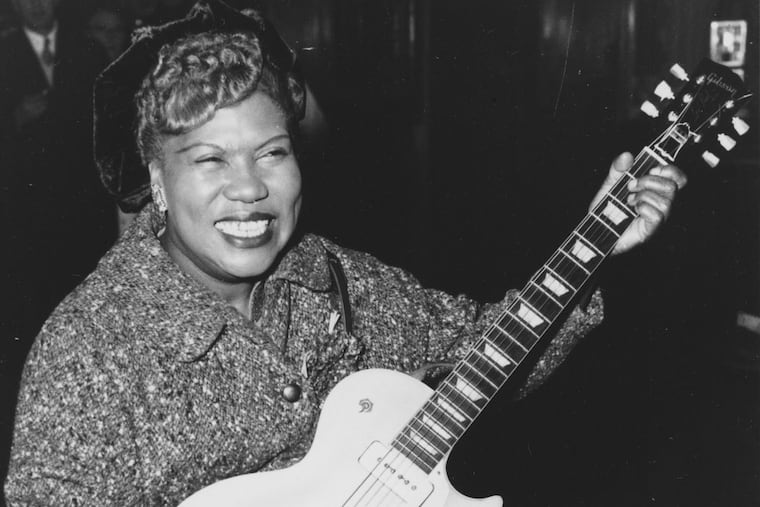Who is Sister Rosetta Tharpe? The Rock and Roll Hall of Fame inductee is buried in Philly
Meet one of rock's great guitarists.

In West Oak Lane's Northwood Cemetery, there now lies a Rock and Roll Hall of Fame inductee.
Sister Rosetta Tharpe was among the artists announced Wednesday as the newest Hall of Famers. Others included Nina Simone, New Jersey's Bon Jovi (a repeat nominee), and New Wave outfit the Cars. Tharpe was inducted as an early influencer.
Those snubbed included Radiohead and Rage Against the Machine.
Tharpe will be inducted into the Hall on April 14 at Cleveland's Public Hall, and the ceremony will be shown on HBO later in the year. A posthumous tribute featuring artists Tharpe influenced will likely be included during the ceremony.
Tharpe was inducted into the Philadelphia Music Walk of Fame this year for her role in establishing the sound of early rock-and-roll music.
She isn't a household name these days, like Jon Bon Jovi, or even Simone, but Tharpe nonetheless is known as "the Godmother of Rock and Roll" becasue of her influence on early rock musicians, like Chuck Berry, Little Richard, Elvis Presley, and Jerry Lee Lewis.
By most accounts Tharpe was born Rosetta Nubin in 1915 in Cotton Plant, Ark. Her mother, Katie Bell Nubin, was a singer and evangelist, and Tharpe began performing with her mother at an early age. She reportedly was a regular on stage by 6.
After marrying preacher Thomas Thorpe when she was 19, Tharpe changed her stage name to include a version of her husband's last name. Even though her marriage lasted only a short time, the stage name stuck.
Tharpe sought to blend gospel with more modern and secular musical influences, eventually leading her to move in 1938 to New York City, where she was signed by Decca Records. That resulted in such hits as "The Lonesome Road," "My Man and I," and "Rock Me," and cemented Tharpe as an early popular gospel singer.
In the 1940s, Tharpe turned even more toward the emerging sound of rock and roll. She worked with Lucky Millinder's orchestra to produce songs such as "I Want a Tall Skinny Papa" and "That's All," the first track featuring Tharpe on electric guitar.
Her popularity skyrocketed during that era thanks to a near-constant tour schedule. During World War II, Tharpe was one of only two African American gospel artists to record V-Discs, records made specifically for the American troops. Tharpe subsequently performed with Benny Goodman, Cab Calloway, and John Hammond, among others.
In 1944, Tharpe joined blues pianist Sammy Price for a series of tracks that further defined the early sound of rock. Among them were "Strange Things Happening Every Day" and "Two Little Fishes and Five Loaves of Bread," both of which combined gospel topics with jazzy, rock music sounds.
Throughout her career, Tharpe released more than a dozen albums that included charting hits, like "Precious Memories" and "Up Above My Head (I Hear Music in the Air)," both from 1948.
According to PhillyJazz.US, Tharpe moved to Philadelphia in 1957. She lived in the city's Yorktown section, where a historical marker was erected outside her home, at 11th and Master, in 2011.
Tharpe joined blues legend Muddy Waters for a European tour in 1970 but fell ill. After returning to the U.S. that year, she suffered a stroke and later had to have a leg amputated due to complications from diabetes.
Three years later, at 58, Tharpe died of a second stroke in Philadelphia, reportedly just before attending a recording session, according to FindAGrave.com. She was buried in Northwood Cemetery.
Today, Tharpe is remembered for her early rock influence and unique guitar playing. According to playwright George Brant, who wrote the musical Marie and Rosetta about Tharpe, just about every major guitar-driven artist has Tharpe to thank.
"Chuck Berry borrowed her guitar stylings, and Little Richard said she was responsible for his career. Elvis Presley counted her as an influence, and even Jimi Hendrix once said he just wanted to play like Rosetta," Brant told the Daily Beast last year. "Jerry Lee Lewis, Bob Dylan, and Johnny Cash have all cited her as influences — which makes it even more frustrating that she fell out of fashion."